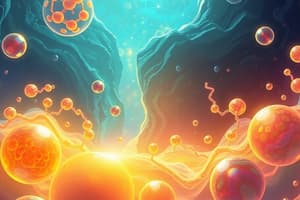Podcast
Questions and Answers
What role do enzymes play in lowering the activation energy barrier?
What role do enzymes play in lowering the activation energy barrier?
Enzymes function as powerful catalysts by lowering the height of the activation energy barrier, facilitating faster reactions.
How do enthalpic factors contribute to enzyme catalysis?
How do enthalpic factors contribute to enzyme catalysis?
Enthalpic factors stabilize the transition state through interactions such as hydrogen bonds, salt links, and covalent interactions.
What is meant by the term 'entropy loss' in the context of enzyme-substrate binding?
What is meant by the term 'entropy loss' in the context of enzyme-substrate binding?
Entropy loss refers to the reduction of the substrate's degrees of freedom as it binds to the enzyme's active site, resulting in a more ordered state.
Can you explain the concept of proximity and orientation effects in enzymatic reactions?
Can you explain the concept of proximity and orientation effects in enzymatic reactions?
What are some alternative terms used by enzymologists to describe entropic contributions?
What are some alternative terms used by enzymologists to describe entropic contributions?
How does substrate binding energy relate to the entropic cost of a chemical event?
How does substrate binding energy relate to the entropic cost of a chemical event?
Why is it said that the reactants in solution possess substantial degrees of freedom?
Why is it said that the reactants in solution possess substantial degrees of freedom?
What is the significance of stabilizing the transition state in enzymatic reactions?
What is the significance of stabilizing the transition state in enzymatic reactions?
What role do functional groups in enzyme active sites play during catalysis?
What role do functional groups in enzyme active sites play during catalysis?
How does substrate binding affect the reaction rates in enzymatic activity?
How does substrate binding affect the reaction rates in enzymatic activity?
What is the significance of intramolecular reactions compared to intermolecular reactions?
What is the significance of intramolecular reactions compared to intermolecular reactions?
Explain the difference in rate constants for the hydrolysis of phenyl acetate and phenyl succinate.
Explain the difference in rate constants for the hydrolysis of phenyl acetate and phenyl succinate.
What is one practical application of the Cleland reagent in enzyme catalysis?
What is one practical application of the Cleland reagent in enzyme catalysis?
What effect does the spatial arrangement of catalytic groups have on enzyme catalysis?
What effect does the spatial arrangement of catalytic groups have on enzyme catalysis?
What advantages does substrate tethering provide in enzymatic reactions?
What advantages does substrate tethering provide in enzymatic reactions?
In what ways do organic model reactions help in understanding enzyme catalysis?
In what ways do organic model reactions help in understanding enzyme catalysis?
Flashcards are hidden until you start studying
Study Notes
Enzymes and How They Work
- Enzymes are powerful catalysts that drastically lower the activation energy of reactions.
- Enzymes achieve this rate acceleration by binding substrates to their active site and creating a proper arrangement of catalytic groups, leading to increased entropy (∆S‡).
- Enzymes also stabilize the transition state by utilizing enthalpic (∆H‡) factors like hydrogen bonds, salt links, acid-base groups, and covalent interactions.
Proximity and Orientation Effects
- Enzymes can increase reaction rates by effectively concentrating the catalytic groups near the substrate.
- This is achieved by binding the substrate within the enzyme's active site, which locks the substrate into a specific conformation.
- The enzyme's active site brings together the catalytic groups and the substrate in a precise orientation for reaction.
- This minimizes the randomness of molecules, leading to an increase in entropy (ΔS‡) due to the loss of degrees of freedom.
- The entropic cost of the reaction can be offset by the energy released in the physical binding process.
- Intramolecular reactions, where the catalytic groups are within the same molecule as the substrate, proceed much faster than intermolecular reactions.
- Substrate tethering (proximity) and proper orientation of catalytic groups result in a significant kinetic advantage.
- The Cleland reagent demonstrates this principle. Dithiothreitol (HS-X-SH) is a better reducing agent compared to two equivalents of monothiol (X-SH). This increase in efficiency is attributed to the intramolecular reaction and a greater entropy gain due to an increase in the number of degrees of freedom.
Importance of Case Studies
- Better understanding of enzyme catalytic components is achieved through various case study examples.
- The catalytic efficiency of enzymes can be explained by analyzing the proximity and orientation effects, covalent catalysis, transition state stabilization, metal ion recruitment, electrostatics, and general acid-base catalysis.
Studying That Suits You
Use AI to generate personalized quizzes and flashcards to suit your learning preferences.




